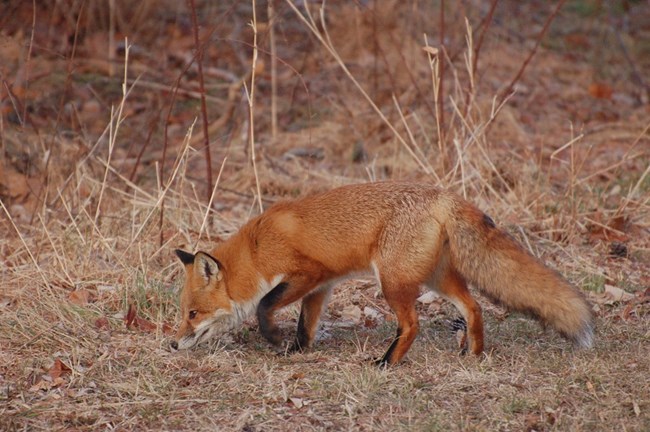
NPS Photo Do You Know Enough to be an 18th Century Naturalist? 1. Europeans had never seen this animal until they came to America. It was easily caught because it often played dead when threatened. Naturalists were fascinated by its pouch where it kept its young.
2. This animal was hunted almost in extinction in Europe because of its thick fur which was used to make hats. Sometimes it was considered a pest because the dams it built across streams flooded portions of the forest. Its large flat tail was considered an excellent food.
3. This gray bushy tailed animal was considered a pest because it ate farmers’ corn crops. They were difficult to hunt when they hid up in the trees. But in 1769, 38 men of Morristown and Mendham proudly announced in the newspaper that they had killed 840 of these pests in one day.
4. This humped-backed, bovine had moved west of the Mississippi River as the eastern lands filled with farms. It lived in large herds on the open plains where they were hunted by Native-Americans who used them to make food, clothing and shelter. A. Deer B. Moose C. Elk D. Buffalo 5. Similar to a plentiful city-dwelling bird, this bird is now extinct. But in the 18th century, this bird was so abundant that during its seasonal migration the flocks darkened the skies for hours. Because they were easy to kill and made good eating, they were hunted into extinction. Officers in Jockey Hollow hunted these birds in the spring of 1780 as they flew overhead.
6. This bright red bird was sometimes captured and kept as a pet, not only because of its appearance but also because of its song.
7. These large black birds were considered pests because they destroyed corn crops. New Jersey and Pennsylvania offered a reward of three pence for each bird that was killed. Despite being considered a pest some people kept these birds as pets. Some people even ate them.
8. This large bird sometimes weighed from 20 to 40 pounds. There were both wild and domesticated varieties of this bird. Both were popular foods. Benjamin Franklin suggested that this bird would be a good symbol for the United States.
9. This scavenger is a large black bird with a featherless red head that primarily eats dead carcasses. It was illegal to kill these birds in Charleston, South Carolina because these scavengers cleaned the carcasses on the city streets.
10. This annoying insect tormented the people of the 18th century, especially those living near marshes or swamps. People built large smoky fires to try to keep these bugs away. Native-Americans covered themselves with bear grease to ward off the bites of these bugs. Though it was not known in the 18th century, these insects also spread diseases like yellow fever and malaria.
11. This deadly snake uses its tail to make a rattling noise when it feels threatened. Not found in Europe, Colonial Americans adopted this snake as an American symbol putting it on flags with the motto “Don’t Tread on Me” A. Garter Snake B. Python C. Anaconda D. Rattlesnake 12. This ore was mined in northern New Jersey and extracted from bogs in southern New Jersey. The ore was converted into a metal in furnaces and forges and used to make everything from cooking pots to nails to cannonballs.
13. These tall, straight evergreen trees were found primarily in the northern territories of New Hampshire and Maine. They were prized by the British for use as ship masts.
14. The sap from these trees was used to make sugar and syrup. Thomas Jefferson hoped that plantations of these trees could rival the sugar plantations of the West Indies.
15. This tree has leaves with three different shapes. While not a strong wood it resisted decay and was used in fence posts. The bark was used to dye wool orange and flavor root beer. The bark was also considered a medicine that cured many diseases. As a result, it was the first forest export of the New World.
Answers can be found at the bottom of the page here: Online Junior Ranger |
Last updated: April 22, 2020
